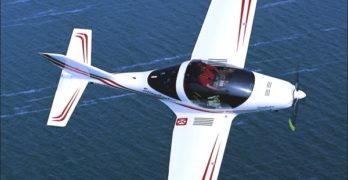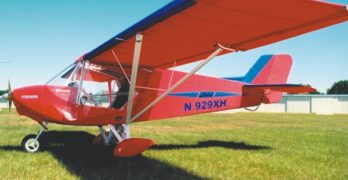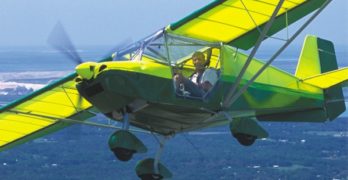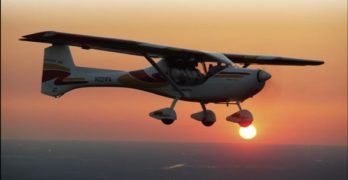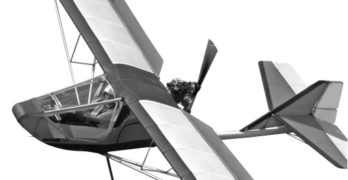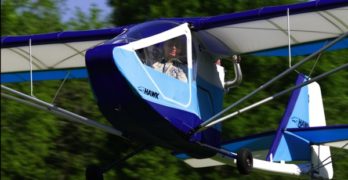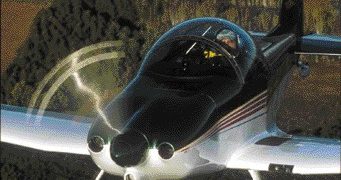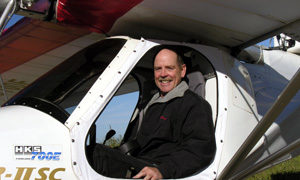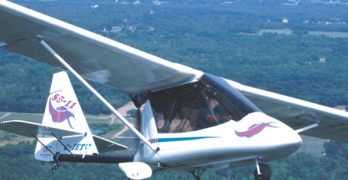A fully loaded, top-of-the-range aircraft
Eastern European aircraft are expected to factor massively in the coming wave of light-sport aircraft (LSA) available to Americans. Several designs have already begun to attract interest as we get closer to approval of the ASTM International consensus standards that will govern the design, construction, and maintenance of these machines. One airplane that generated significant interest at EAA AirVenture Oshkosh for the last three years is the TL-2000 Sting.
Common to designs we’re seeing from Eastern Europe, the TL-2000 Sting from TL Ultralight in the Czech Republic is a sleek, composite aircraft with impressive performance and handling. The Sting series evolved from an earlier TL Ultralight design called the TL-96, and both aircraft cater to the European ultralight market, which has allowed the manufacture of LSA-category aircraft under European microlight regulations. Now, the TL-2000 and TL-96 are being reworked to meet LSA requirements. The planes have been renamed the StingSport and StarSport respectively to designate the aircraft that will be LSA-compliant.
Search Results for : Revo
Not finding exactly what you expected? Try our advanced search option.
Select a manufacturer to go straight to all our content about that manufacturer.
Select an aircraft model to go straight to all our content about that model.
New Look for Xair Import; Xair H
UPDATE 2008: The following article preceded the arrival of the X-Air LS offered by X-Air LSA, certified in 2008 as a Special Light-Sport Aircraft under ASTM standards. The article below appears unchanged from the original, but the airframe is essentially identical. So, while panel changes were made along with a few minor updates, flying qualities reported in the following article should largely match that of the new LSA version.
It was Tax Day, April 15, and I prepared to fly an Xair H (N#929XH) owned by importer Bill Magrini of Light Wing Aircraft. It seemed an appropriate day to forget about what I owed the Internal Revenue Service and to enjoy some ultralight flying. Fortunately, the Xair H didn’t disappoint.
The Xair H isn’t the designer or fabricator’s name for the new plane. When I first saw the then-prototype design at a French airshow in ’02, the new model was named Hanuman, which means little to American pilots.
Sky Ranger Defines a New Niche
Listening to the aviation media drumbeat about Sport Pilot/Light-Sport Aircraft, you could be excused for thinking ultralights had “vanished” and that it now takes $55,000 to $95,000 to buy a light recreational aircraft. Fortunately, this just isn’t so.
We’re beginning to identify the emergence of a middle ground and the Sky Ranger is positioned in this space. According to my Sky Ranger check pilot Ryan Gross, our test plane could be supplied by Sky Ranger Aircraft Company for $40,000 in ready-to-fly form. While this is significantly more than the Sky Ranger 503 kit I flew four years ago, it is about half the cost of the average new 3-axis light-sport aircraft (LSA), though some models, like the Fantasy Air Allegro 2000, are only $15,000 more than the Sky Ranger.
Regardless of how the Sky Ranger Aircraft Company may elect to supply fully-built aircraft versus kits, the design of this airplane was optimized to be a quick and easily-built kit.
An Introduction to Light-Sport Aircraft
Sport pilot and light-sport aircraft,
what’s it all about?
If you’ve ever thought about
learning to fly, returning to
flying, or resuming flying lessons
that you started years ago,
congratulations; your timing is
just about perfect! This rule provides
new opportunities for you as well as
anyone who has dreamed of owning
an aircraft.
This article will summarize how
SP/LSA affects you. We’ll keep it simple;
when you’re ready for more,
EAA offers many ways to become
more informed (see “For More
Information”). Like many activities,
flying has its own language with
abbreviations, acronyms, forms, and
numbers to make discussing it faster.
Veteran pilots throw this lingo around
casually and often baffle those who
aren’t involved. We’ll avoid such jargon
in this article, and we’ll only use
abbreviations after we’ve explained
them.
Let’s Get Started!
SP/LSA has two basic components:
“Sport pilot” refers to a new pilot
certificate you can earn (the FAA calls
them certificates as opposed to licenses);
“Light-sport aircraft (LSA)” refers
to a new category of aircraft.
CGS Aviation Makes Hawk
Remember why we fly ultralights? Few general aviation airplanes are flown below 1,500 feet above the ground. More rare is flight at 500 feet or 50 feet. Neither do you tend to fly most light-sport aircraft (LSAs) at these denser altitudes. Most flights in general aviation or LSA planes start out climbing high as quickly as possible. You switch on the autopilot as soon as possible and fiddle with the throttle, prop and mixture controls to squeeze all the fuel economy you can while flying as fast as the machine will manage in the straightest possible line all the way to your destination.
That’s fine for general aviation or LSA flying, and it’s enjoyable in a different way. But it isn’t ultralight flying.
What about just “boating around” the sky at your leisure, turning every few minutes to see the sights only possible from an ultralight aircraft. Your eye catches an alligator off to one side and you bank quickly to check it out.
CGS Pulls Out the Stops
… to keep the Hawk Ultra Light
Genuine ultralights still
have a place. These
aircraft|excuse me,
ultralight vehicles,
the least-FAA-regulated
flying machines,
will not be sent to aircraft boneyards
despite what some light-sport aircraft
skeptics may think. The Hawk Ultra
is proof positive CGS Aviation loves
ultralights and wants you to have fun
in the air.
No matter the pros and cons of
the sport pilot/light-sport aircraft (SP/
LSA) rule, operating a Part 103 ultralight
remains simpler than earning a
sport pilot certificate and buying an
LSA. No certificate, no medical, and
no registration is needed (though, it is
recommended that folks register with
one of the three associations supporting
ultralights-EAA, the United States
Ultralight Association (USUA), and Aero
Sports Connection (ASC). Additionally,
an ultralight can be fully factory built
without FAA inspections. The list of 103
privileges goes on, and the Hawk Ultra
qualifies for all of them.
One-Oh-Three Interest Soars
I don’t know about the “build it
and they will come” premise when
it comes to baseball fields, but I fervently
believe that if enough customers
want a product, someone will supply
it.
Ultralight Trainers for the Future
A more real concern about the
future of ultralights revolves around
the availability of ultralight trainers
to prepare new pilots for flight in
Part 103 ultralights like the Ultra.
Wonderful as many of the new LSA
may be, most are inappropriate aircraft
to train you for flight in a Hawk
Ultra|or almost any other genuine
103 machine. The question ponders
the likelihood of companies building
ultralight trainer-type aircraft as
fully built, fully certificated special
light-sport aircraft (S-LSA), the minimum
standard to which all trainers
must be built once the two-place
exemptions expire on January 31,
2008. (Note: Two-place trainers that
have transitioned to experimental
light-sport aircraft status, E-LSA, can
still be used for training purposes by
the original owner/instructor until
January 31, 2010.)
Even if ultralight manufacturers
do choose to build an S-LSA trainer,
will it be affordable? Again, consumer
demand will play a role in
this decision; CGS is evaluating the
market and may create an S-LSA
ultralight trainer.
World’s Fastest Mustang II?
When most of us think about a fast airplane, we sketch in our minds a sleek and smooth exterior and wings that allow the graceful machine to slip through the air with the least possible resistance. We think the engine is also important and that more power is better than less.
But according to race winner Brian Schmidtbauer, up to 30% of the total drag in an aircraft can be cooling drag, or air movement through the engine compartment.
Because I often review gliders and slower powered aircraft, I’m sure I displayed a slack-jawed response to this comment. The stunned expression stayed on my face as Schmidtbauer described detail after detail about the handling of cooling air.
After an hour-long flight in his blazing Mustang II, I came away a believer. His homebuilt aircraft has beaten the likes of jet-smooth Lancairs and isn’t threatened by speedy RVs. In fact, only his buddy and RV-4 pilot Dave Anders has beaten Schmidtbauer in a race, and they’re so close that the next race might be different.
Back in the Saddle in a Flightstar Ultralight
On a glorious fall day over the undulating hills of northeast Connecticut, I returned to flight after a five-month hiatus. Encouraged and accompanied by my old friend Tom Peghiny we enjoyed an hour sightseeing flight over the verdant countryside surrounding Tom’s Flightstar Sportplanes enterprise at the Woodstock airport. Gosh, it felt great to get back in the air! *** With the first revolution of the wheels I noticed how light the Flightstar seemed. I’ve done most of my flying in Light-Sport Aircraft lately and I guess I’d forgotten just how light ultralights can feel. We left the ground in a couple hundred feet lifted by a HKS 700E four stroke distributed by HPower. In an age of $100,000 LSA, this $25,000 Flightstar IISC certainly seems affordable to plenty of Americans. At 400 pounds less than LSA at gross, turns were pleasant low-gee maneuvers.
Eye On the Sky Watch
There was a time when a company called Beaver RX Enterprises – which produced the Canadian Beaver designs – was among the leading North American ultralight manufacturers.
In particular, the Beaver 550 tandem 2-seater attracted many customers. The company once claimed more than 3,500 ultralights flying. Certainly the model dominated the western Canadian market but also had a presence in the U.S. and other countries.
The old Beaver RX Enterprises company went through a number of leadership changes and, driven by overly-ambitious management goals, finally succumbed.
When I visited the now defunct company, the firm was a publicly-held corporation listed on the Vancouver Stock Exchange. Even the stock exchange has experienced a transformation, so perhaps it isn’t surprising that Beaver RX Enterprises also lost its heading.
As we’ve seen with other good designs, however – such as Quicksilvers, Phantoms or Drifters – the better ultralights can outlast their ownership. The Beaver line is among those survivors.
- « Previous Page
- 1
- …
- 10
- 11
- 12
- 13
- 14
- 15
- Next Page »


